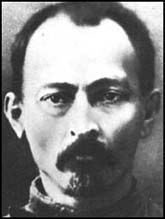 |
The Red Terror was carried out in post-revolutionary Russia by the Cheka headed by Felix Dzerzhinsky along with units of the Red Army. The Red Terror started as a result of an attempt to kill Vladimir Lenin by Fanni Kaplin in August 1918 and the murder of the Cheka leader in St. Petersburg. This failed assassination attempt on Lenin was used as a rationale for the secret police and the army to round up and deal with anyone suspected of counter-revolutionary activities. From his hospital bed Lenin instructed the Cheka to “prepare for terror”.
There was no obvious government body that could hold back the work of the Cheka. Dzerzhinsky could simply explain the organisation’s work: for example the arrest and execution of 800 people in St. Petersburg in 1918 was explained away as those executed were ‘enemies of the state’ or ‘enemies of the revolution’. Few were brave enough to argue with such an accusation in case they themselves were accused of the same crime. None of the 800 was put on trial. They were arrested and then shot. Dzerzhinsky himself said that the Cheka operated on a 24 hour basis: those who were held were usually dealt with within 24 hours. The Red Terror last from September 1918 to October 1918 though some believe that it actually lasted until the end of the Russian Civil War. The work of the Cheka during the Red Terror received the support of Lenin who argued on its behalf that the people they were dealing with were trying to re-establish into power those who had abused and exploited others in pre-revolutionary Russia. Above all else Lenin wanted to keep what had been won during the months of 1917. Therefore the Cheka was given effectively a free rein in Russia. Someone’s occupation or the size/value of their house could be enough to seal their fate.
The work done during the Red Terror also received support from a leading Bolshevik – Gregory Zinoviev. He said that the enemies of the Bolshevik government should be “annihilated”. Lenin himself wrote to Dzerzhinsky that the opponents of the Bolshevik government should be made “to tremble”.
Given that the future USSR was in chaos in 1918 and that the work was done by the secret police, it is hard to find accurate figures of those who suffered during the Red Terror. If it was done to make people “tremble” then there is a chance that the figures were exaggerated simply to scare potential opponents into acquiescence. It is thought that between 10,000 to 15,000 people were summarily executed by the Cheka between September and October 1918 in areas under the formal control of the Bolsheviks – such figures were published in official journals and openly publicised. As there were no public trials, such figures cannot be verified. However, it is thought that the figures for summary executions in areas previously under the control of the Whites were far higher than 15,000. Lenin himself gave the order for the execution of 50,000 in the Crimea alone and some include these figures as part of the “Red Terror” as opposed to being the end result of the Russian Civil War.
The Red Terror resulted in the execution of thousands of men classified as “bandits”. However, the term never had a legal definition and it seems very likely that it became a one-word fits all to explain the arrest and then execution of suspects. Those who harboured the thousands of deserters from the Red Army were arrested and punished as they were branded “bandits”. This meant that many families suffered as the result of just one member of it defying the law.